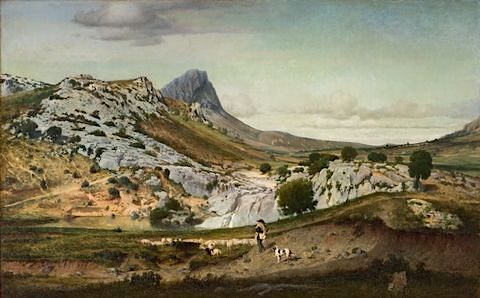Pic Saint Loup (658 m - 2,159ft)
France (Occitanie)
In Les Garrigues du Pic Saint Loup, oil on canvas, 1859- Musée Fabre, Montpellier, France
Pic Saint Loup (658 m - ) is a mountain in the Occitanie region of
France located on the edge of the municipalities of Valflaunes and
Cazevieille.Located about 20 km north of Montpellier, the peak is
visible from a large part of the department of Hérault, the coast and
the Gard, hence its profile evokes a point rushing to the sky. It is one
of the most beautiful natural and hiking sites in the Garrigues region,
the Cévennes outpost. The mountain is also considered the "Sainte-Victoire"
of Languedoc. It forms, with the mountain of Hortus facing it to the
north, a protected natural site and hosts a number of birds of prey..
From the top of its sharp ridge, the peak Saint-Loup stands against the elements. A large iron cross is erected, an observation post and the chapel of an old hermitage.
The painter
Eugene Castelnau belongs to a family of the Protestant bourgeoisie of Montpellier. and the cousin of the painter Frédéric Bazille. He followed Charles Matet's drawing classes at the Montpellier School of Fine Arts, and in 1841 he left his hometown for Switzerland. He then studied in Paris, in the workshops of Alexandre Calame and Charles Gleyre.
In 1853, Eugene Castelnau stayed in Italy. In Rome, he attended the painter Ernest Hébert, he traveled for four months the campaign of Rome and the Bay of Naples. Édouard-Auguste Imer noted day after day the details of the trip. His first painting, Les Marais pontins, is presented at the 1855 World's Fair in Paris.
Eugene Castelnau participated in the political and artistic life of Montpellier. He was deputy mayor from September 1870 to April 1871. In 1873, he became president of the Artistic Society of Herault.
From the top of its sharp ridge, the peak Saint-Loup stands against the elements. A large iron cross is erected, an observation post and the chapel of an old hermitage.
The painter
Eugene Castelnau belongs to a family of the Protestant bourgeoisie of Montpellier. and the cousin of the painter Frédéric Bazille. He followed Charles Matet's drawing classes at the Montpellier School of Fine Arts, and in 1841 he left his hometown for Switzerland. He then studied in Paris, in the workshops of Alexandre Calame and Charles Gleyre.
In 1853, Eugene Castelnau stayed in Italy. In Rome, he attended the painter Ernest Hébert, he traveled for four months the campaign of Rome and the Bay of Naples. Édouard-Auguste Imer noted day after day the details of the trip. His first painting, Les Marais pontins, is presented at the 1855 World's Fair in Paris.
Eugene Castelnau participated in the political and artistic life of Montpellier. He was deputy mayor from September 1870 to April 1871. In 1873, he became president of the Artistic Society of Herault.
___________________________________________
2019 - Wandering Vertexes...
by Francis Rousseau

















